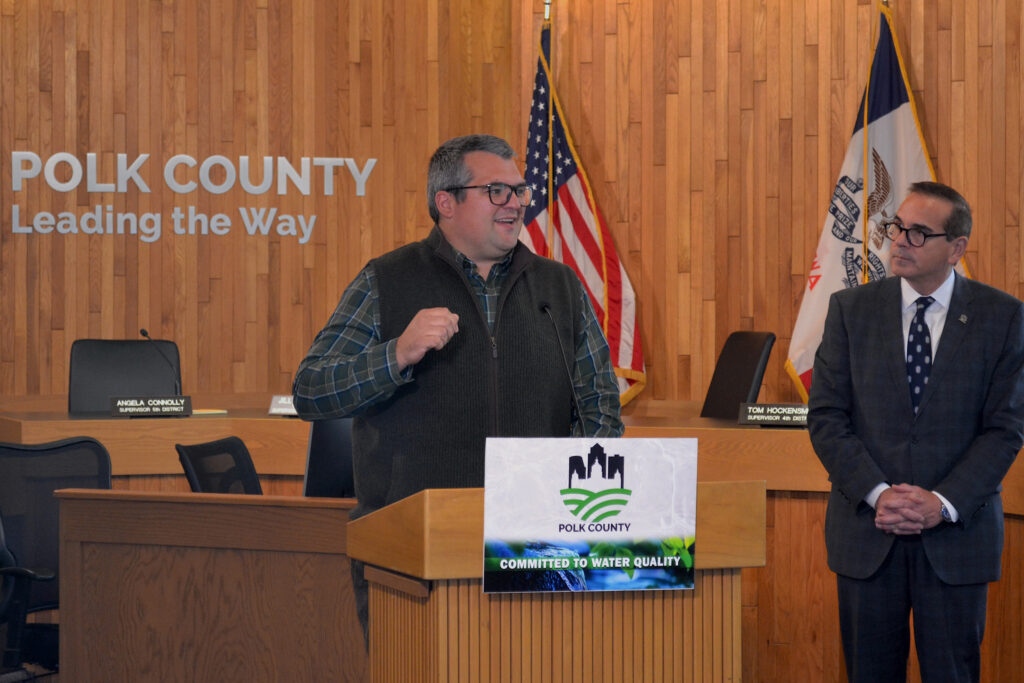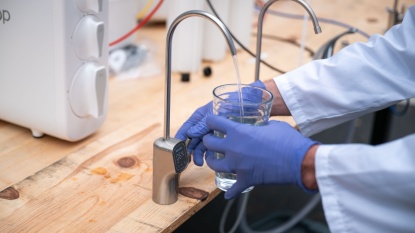Iowa Counties Keep Water Quality Monitoring Afloat After State Funding Cuts – Inside Climate News

Report on Iowa’s Water Quality Monitoring and Sustainable Development Goals
Executive Summary
A critical water quality monitoring network in Iowa, essential for tracking progress towards Sustainable Development Goal 6 (Clean Water and Sanitation), faced termination due to state funding cuts. In response, Polk County has committed $200,000, demonstrating a local partnership model under SDG 17 (Partnerships for the Goals) to safeguard public health and water resources. This report details the network’s function, the challenges posed by agricultural pollution, and the local government’s intervention to ensure data continuity for sustainable water management.
Water Monitoring Infrastructure and its Role in Achieving SDG 6
The University of Iowa’s hydroscience and engineering center manages a network of 60 water quality sensors, which forms the backbone of the state’s capacity to monitor and manage its freshwater ecosystems, a key target of SDG 6.
Network Capabilities
- Real-Time Data Collection: The sensors provide continuous, publicly available data, measuring key water quality indicators at 10-minute intervals.
- Key Parameters Monitored:
- Nitrate concentrations (linked to agricultural runoff)
- Oxygen concentrations
- pH levels
- Stream flow and temperature
- Public Information System: Data is uploaded to the Iowa Water Quality Information System, promoting transparency and enabling informed decision-making for researchers, government agencies, and the public, directly supporting SDG Target 6.b on community participation in water management.
Challenges to Water Security and Sustainable Communities (SDG 6 & SDG 11)
Iowa’s water quality crisis, primarily driven by agricultural runoff, presents a significant threat to achieving clean water access and creating sustainable communities. The state’s withdrawal of funding has exacerbated this challenge.
Impact on Public Water Supply
- Pollution Source: The Raccoon and Des Moines rivers, which supply drinking water to over 500,000 residents in Polk County, recorded near-record high levels of nitrate pollution. This directly compromises SDG Target 6.1 (safe and affordable drinking water) and SDG 11 (Sustainable Cities and Communities).
- Financial Burden: Des Moines Water Works has invested millions in a nitrate-removal facility, spending nearly $10,000 per day on operations during pollution spikes. This cost reflects the economic consequences of environmental degradation on urban infrastructure.
Government Funding and Policy Gaps
- In 2023, the Iowa Legislature cut $500,000 in funding previously allocated to the sensor network via the Iowa Nutrient Research Center.
- These funds were redirected to support voluntary on-farm conservation practices, shifting policy from monitoring and accountability to voluntary action.
- This legislative action created a critical data gap, undermining the state’s ability to measure the effectiveness of its Nutrient Reduction Strategy and report on progress towards SDG 6.
Local Intervention as a Model for SDG 17: Partnerships for the Goals
In the absence of state and federal support, local government and philanthropic organizations have formed partnerships to sustain the vital monitoring network, embodying the principles of SDG 17.
Polk County’s Strategic Investment
The Polk County Board of Supervisors unanimously approved a $200,000 investment to maintain the sensor network. This action was informed by the Central Iowa Source Water Research Assessment, which identified continued monitoring as a critical need.
Multi-Stakeholder Collaboration
- County Government: Polk County’s funding will cover network operating expenses for one year, beginning in 2026.
- Philanthropy: A donation from the Walton Family Foundation is currently sustaining the network’s operations until the county funds become available.
- Inter-County Cooperation: Discussions are underway with other major population centers, including Johnson and Linn counties, to build a broader coalition of local support.
This collaborative approach demonstrates a commitment to data-driven decision-making and serves as a powerful example of local stakeholders taking responsibility for achieving the Sustainable Development Goals when higher levels of government fail to act.
Analysis of Sustainable Development Goals in the Article
1. Which SDGs are addressed or connected to the issues highlighted in the article?
-
SDG 6: Clean Water and Sanitation
This is the most central SDG to the article. The text focuses on a “water quality crisis” in Iowa caused by nitrate pollution from agricultural runoff. It discusses the impact on drinking water for the residents of Polk County and the efforts to monitor and manage the quality of the Raccoon and Des Moines rivers.
-
SDG 11: Sustainable Cities and Communities
The article highlights the direct impact of the water crisis on Polk County, the state’s largest county with 500,000 residents. The local government’s decision to invest in the monitoring network is driven by the need to protect the drinking water source for its urban population and manage the high costs associated with water treatment (e.g., the nitrate-removal facility in Des Moines).
-
SDG 15: Life on Land
The pollution from agricultural runoff directly degrades inland freshwater ecosystems, which is a key concern of SDG 15. The monitoring of streams and rivers is essential for assessing the health of these ecosystems and evaluating the effectiveness of strategies like the “Iowa Nutrient Reduction Strategy.”
-
SDG 17: Partnerships for the Goals
The article describes a multi-stakeholder partnership formed to address the issue. After state government funding was cut, the University of Iowa’s monitoring network is being sustained through a collaboration involving a local government (Polk County), a private foundation (Walton Family Foundation), and the university itself. This demonstrates a partnership to achieve a common goal.
2. What specific targets under those SDGs can be identified based on the article’s content?
-
Target 6.3: Improve water quality by reducing pollution
The article is entirely focused on this target. It discusses the problem of “nitrate pollution” from “agricultural runoff” and the importance of the sensor network to “evaluate the success of the Iowa Nutrient Reduction Strategy,” which is aimed at improving water quality.
-
Target 6.b: Support and strengthen the participation of local communities in improving water and sanitation management
The Polk County Board of Supervisors voting to invest $200,000 to keep the sensors online is a direct example of a local community taking action and participating in the management of its water resources, especially after state-level support was withdrawn.
-
Target 11.6: Reduce the adverse per capita environmental impact of cities
The article notes that Des Moines Water Works has invested millions in a nitrate-removal facility and spends “nearly $10,000 a day” to operate it when nitrate levels are high. This highlights the significant environmental and financial burden that poor water quality places on a city, which this target aims to reduce.
-
Target 15.1: Ensure the conservation, restoration and sustainable use of terrestrial and inland freshwater ecosystems and their services
The monitoring of rivers and streams is a fundamental step toward the conservation and restoration of these freshwater ecosystems. The data collected helps in understanding the extent of pollution and guiding efforts to mitigate it, such as planting buffer strips or installing bioreactors.
-
Target 17.17: Encourage and promote effective public, public-private and civil society partnerships
The funding model for the sensor network exemplifies this target. It is a partnership between a public university (University of Iowa), a local public entity (Polk County), and a private foundation (Walton Family Foundation) to maintain a critical public service.
-
Target 17.18: Increase significantly the availability of high-quality, timely and reliable data
The core purpose of the sensor network is to provide “publicly available,” “real-time data” on water quality. The article emphasizes the importance of this data for researchers, government agencies, and landowners, stating, “We need to keep monitoring. We need to keep looking at the data.”
3. Are there any indicators mentioned or implied in the article that can be used to measure progress towards the identified targets?
- Ambient water quality measurements: The article explicitly states that the sensors measure “nutrient nitrate… as well as oxygen concentrations, pH, stream flow and temperature.” These are direct physical and chemical indicators used to assess water quality, relevant to SDG Target 6.3. The mention of “near record-high levels of nitrate pollution” is a specific data point.
- Availability of timely and public data: The network provides “real-time data” from “60 sensors” taking measurements at “10-minute intervals” and uploading them to the public “Iowa Water Quality Information System.” This serves as an indicator for data availability and accessibility under SDG Target 17.18.
- Financial investment in water quality management: The article mentions specific financial figures that can be used as indicators. This includes the “$200,000” investment from Polk County, the “$500,000” in funding cut by the state legislature, and the “nearly $10,000 a day” cost for the city of Des Moines to operate its nitrate-removal plant. These figures indicate the level of financial commitment and the economic impact of pollution.
- Local government participation: The unanimous vote by the Polk County Board of Supervisors to fund the network is a clear indicator of local community engagement and governance in water management, relevant to SDG Target 6.b.
4. Summary Table of SDGs, Targets, and Indicators
| SDGs | Targets | Indicators |
|---|---|---|
| SDG 6: Clean Water and Sanitation |
6.3: Improve water quality by reducing pollution.
6.b: Support and strengthen the participation of local communities in improving water and sanitation management. |
– Concentration levels of nutrient nitrate, oxygen, and pH in waterways. – Unanimous vote and $200,000 investment by Polk County Board of Supervisors. |
| SDG 11: Sustainable Cities and Communities | 11.6: Reduce the adverse per capita environmental impact of cities, including by paying special attention to water quality. | – Daily operational cost ($10,000/day) of the Des Moines nitrate-removal facility. |
| SDG 15: Life on Land | 15.1: Ensure the conservation and sustainable use of inland freshwater ecosystems. | – Continuous monitoring of 60 streams and rivers to track the movement of nitrate and assess ecosystem health. |
| SDG 17: Partnerships for the Goals |
17.17: Encourage and promote effective public, public-private and civil society partnerships.
17.18: Increase the availability of high-quality, timely, and reliable data. |
– Collaboration between the University of Iowa, Polk County, and the Walton Family Foundation. – Operation of a network of 60 sensors providing real-time, publicly available data every 10 minutes. |
Source: insideclimatenews.org
What is Your Reaction?
 Like
0
Like
0
 Dislike
0
Dislike
0
 Love
0
Love
0
 Funny
0
Funny
0
 Angry
0
Angry
0
 Sad
0
Sad
0
 Wow
0
Wow
0
















































/environment-climate-change-and-health-(ech)/water-sanitation-hygiene-and-health-(wsh)/landfill-tuvalu-36092.tmb-1200v.jpg?sfvrsn=5c21fe40_1#)

.jpg.webp?itok=0ZsAnae9#)


























